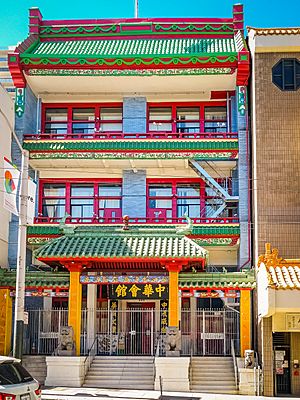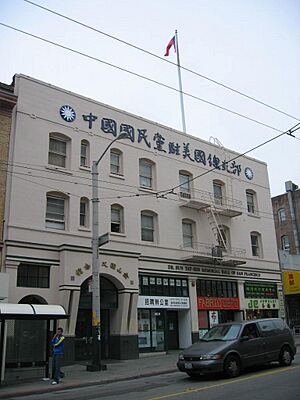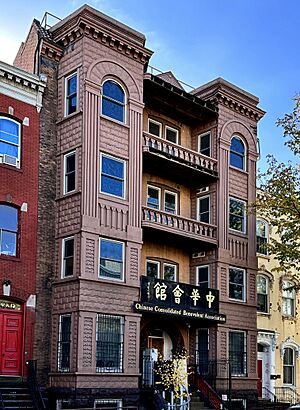Chinese Consolidated Benevolent Association facts for kids
Quick facts for kids Chinese Consolidated Benevolent Association |
|||||||||||
|---|---|---|---|---|---|---|---|---|---|---|---|
| Traditional Chinese | 中華會館 | ||||||||||
| Simplified Chinese | 中华会馆 | ||||||||||
|
|||||||||||
| Alternative Chinese name | |||||||||||
| Traditional Chinese | 中華公所 | ||||||||||
| Simplified Chinese | 中华公所 | ||||||||||
|
|||||||||||
| Second alternative Chinese name | |||||||||||
| Chinese | 六大公司 | ||||||||||
| Literal meaning | big six companies | ||||||||||
|
|||||||||||
The Chinese Consolidated Benevolent Association (CCBA) is an old organization that was created to help Chinese immigrants in the United States and Canada. It was formed in places where many Chinese people lived.
In the late 1800s and early 1900s, the CCBA mainly helped Chinese immigrants from a specific area in southern China called the Pearl River Delta in Guangdong province. Later, after 1965, new Chinese immigrants came from many different parts of China. They didn't face as much hardship as the earlier groups, so they didn't join the CCBA as much. This made the CCBA less powerful over time.
Contents
What the CCBA is Called
The CCBA has different names depending on where it is. For example, in San Francisco, it was often called the Chinese Six Companies, especially when it first started. In Seattle, it's known as the Chong Wa Benevolent Association. In Honolulu, it's called the United Chinese Society.
In the western and central parts of the United States and Canada, the Chinese name is 中華會館. In the eastern parts of the United States and Canada, it's called 中華公所. The word 中華 means "Chinese" in a way that refers to the Chinese people and nation. Both 會館 and 公所 were historical names for groups that helped people from the same area or trade.
How the CCBA Helped People
The Chinese Consolidated Benevolent Association (CCBA) was officially started in 1882 in San Francisco's Chinatown. It began in the 1850s to help Chinese immigrants. At that time, many Americans didn't understand Chinese culture, and there was a lot of unfair treatment against Chinese people. This made it very important for Chinese communities to have a strong organization like the CCBA.
The CCBA helped Chinese people travel to and from the US. It even helped send the bodies of those who passed away back to China. Many families were separated, so the association also provided care for the sick or poor. As unfair treatment against Chinese people grew, the CCBA also offered legal help and protection. Sometimes, Chinese people in Chinatown faced physical harm from racist individuals. Groups like the tongs also emerged to protect Chinese people from such harm.
The CCBA also became a powerful voice for Chinese communities across the US. Its leaders were often wealthy merchants and business people. They worked with local and national governments. They even hired a non-Chinese lawyer to speak for them, which helped them be heard more easily.
In the 1800s, many Chinese immigrants came to California for the gold mines. They played a big part in the state's economic growth. When gold mining slowed down, Chinese immigrants found other jobs like fishing, cooking, farming, and building railroads. Some people thought that Chinese immigrants took jobs away from American citizens. However, many Chinese immigrants created their own jobs because of language differences.
The CCBA in San Francisco
Early History of the Six Companies

When Chinese immigrants arrived during the California gold rush, they felt the government in America wasn't protecting them. To help each other, these early Chinese settlers from the Pearl River Delta formed groups like the Sze Yup and Sam Yap associations in San Francisco's Chinatown. As more Chinese immigrants arrived from different areas and spoke different dialects, more associations were formed. These eventually became the six most important Chinese district associations in California. They worked together even before the CCBA was officially created in 1882.
These immigrant groups were based on a Chinese tradition called huiguan (traditional Chinese: 會館; simplified Chinese: 会馆; Mandarin Pinyin: huìguǎn; Jyutping: wui6gun2). These were support groups for people from the same region or trade. Most Chinese people in California came from the Pearl River Delta in Guangdong province. The first huiguan, called the Sam Yap (Chinese: 三邑; Mandarin Pinyin: sānyì; Jyutping: sam1 jap1; Cantonese Yale: Sāmyāp; literally "Three counties") Company, started in 1851. It helped people from Nanhai, Panyu, Shunde, Sanshui, and Xingyun districts. Later in 1851, the Sze Yap (Chinese: 四邑; Mandarin Pinyin: Sìyì; Jyutping: sei3 jap1; literally "Four Counties") company was formed for people from Xinhui, Kaiping, Xinning, and Enping districts. Then came the Yeong Wo (Chinese: 陽 和) company in 1852, and the Hip Kat company, formed by Hakka immigrants, also in 1852. This meant Chinese people in California were organized into four main groups based on their dialects.
Because of disagreements within the large Sze Yup company, the Ning Yung (Chinese: 寧 陽) company was formed in 1853. The Hop Wo (Chinese: 合 和) company split off in 1862. In 1867, the Sze Yup company, which had become smaller, was reorganized as the Kong Chow (Chinese: 岡 州) company. Later, in 1878, the Sue Hing (Chinese: 肇 慶) company was formed from the Hop Wo company.
The Six Companies acted as representatives for the Qing government, which didn't have a consulate in Chinatown until the late 1870s. They offered many services to Chinese immigrants and workers in San Francisco. They tried to encourage good behavior in the Chinese community and helped sick Chinese workers by lending them money. They also opened a Chinese-language school, helped settle disagreements, kept records of Chinese residents, and helped members send money back to their families in China.
One of the most important jobs of the CCBA was to protect the civil rights of Chinese people. For example, they hired police officers to watch over Chinese businesses in San Francisco. They also hired non-Chinese lawyers to fight against unfair laws at the city, state, and national levels. A very important case in 1898, called Wong Kim Ark, helped establish that children born in the US to Chinese parents were US citizens. The CCBA helped win this case with legal support.
New Immigrants in the 1960s
Even though the Six Companies had discouraged more Chinese immigration to the US, people continued to arrive. In the 1960s, some differences started to appear within Chinese communities. Many Chinese people who were born in America had adopted American culture. This sometimes caused cultural differences with new immigrants. Many new Chinese immigrants arrived in America with little money, as most of it was spent on travel. Children of these new immigrants often had to work when they weren't in school and struggled to learn English.
In 2022, the CCBA in San Francisco welcomed its first female president, who was the head of the Yan Wo company.
The CCBA in New York City
In New York City, the CCBA was started in 1883. It acts as a main organization for sixty other groups that represent different parts of New York's Chinese community. These include groups for professionals, businesses, religious groups, cultural groups, women's groups, and organizations like the Lin Sing Association.
The CCBA helped create the Chinese Voters Federation in May 2004. This group encouraged Chinese American citizens to register and vote in the 2004 presidential election.
After the 2004 Indian Ocean earthquake and tsunami happened, the CCBA quickly led a community effort to raise money for the victims. They raised over $500,000 for the American Red Cross. In September 2005, after Hurricane Katrina, the CCBA and Sing Tao Daily worked together and raised $170,000 for the victims.
The CCBA also works with many larger organizations to help the Chinese American community. For example, they partner with the Visiting Nurse Service of New York and the American Cancer Society. In December 2006, the CCBA and the American Red Cross of Greater New York agreed to work together to prepare the Chinese community for emergencies.
The CCBA in New England
The Chinese Consolidated Benevolent Association of New England, also known as CCBA, is an organization that started in 1923. It has 35 member groups, including family associations and community organizations. The CCBA serves as the main organization for Chinese communities in New England.
Besides supporting various activities, the CCBA manages Tai Tung Village and Waterford Place. These are apartment complexes that offer affordable homes to the Chinese community. The CCBA also works with other groups like Chinatown Main Street to organize events such as the lion dance celebration for the Lunar New Year and the yearly August Moon Festival. These events help attract visitors and boost the economy in Chinatown. The CCBA also hosts important visitors to the Chinatown community.
The CCBA in Seattle
In Seattle, Washington, the Chong Wa Association was established around 1915.
The CCBA in Vancouver
CCBA Locations
The CCBA has many branches in the United States and Canada, including:
- Augusta, Georgia
- Bakersfield, California
- Boston, Massachusetts
- Chicago, Illinois
- Cleveland, Ohio
- Detroit, Michigan
- Edmonton, Alberta
- Fresno, California
- Honolulu, Hawaii
- Houston, Texas
- Littleton, Colorado
- Los Angeles, California
- Marysville, California
- Montreal, Quebec
- New York City, New York
- Oakland, California
- Philadelphia, Pennsylvania
- Portland, Oregon
- Regina, Saskatchewan
- Sacramento, California
- Salinas, California
- San Diego, California
- San Francisco, California
- Seattle, Washington
- Stockton, California
- Toronto, Ontario
- Vancouver, British Columbia
- Victoria, British Columbia
- Washington, D.C.
- Windsor, Ontario
See also
- Chinese Clan Association
- Kongsi
- List of Chinese American Associations
- Chinese Boycott of 1905
- Chinese Cemetery of Los Angeles








